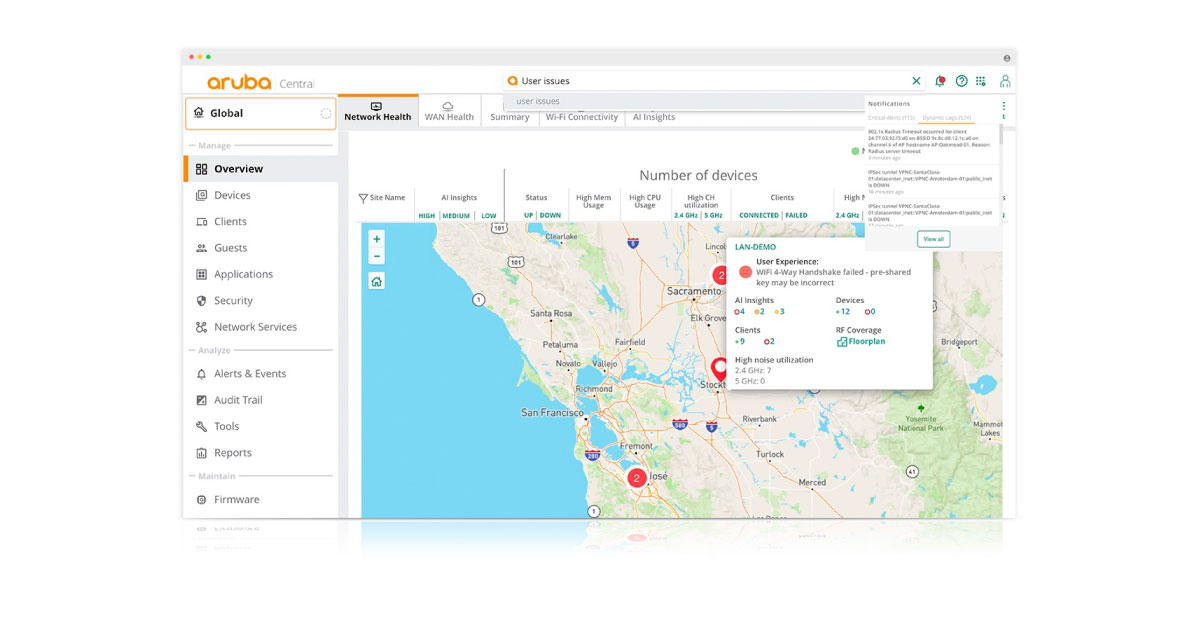Aruba Central is a cloud-based network management platform developed by Aruba Networks. It provides a centralized and secure way to manage and monitor wired and wireless networks from a single location. In this blog, we will discuss the various use cases of Aruba Central and how it can benefit organizations and simplify network management for IT staff.

Simplifying Network Management
Aruba Central provides a single pane of glass view of all network devices, including access points, switches, and gateways. This allows network administrators to manage and monitor the network from anywhere in the world, without the need for on-premises hardware or software. Network administrators can also configure network policies, set up alerts, and manage users and devices from a centralized dashboard.
Improving Network Security
Aruba Central provides a comprehensive set of security features to help organizations protect their networks from cyber threats, including:
- Role and Identity-Based Access Control: Aruba Central allows network administrators to manage access to network resources based on user roles and identity. This granular access control policy helps prevent unauthorized access to sensitive data and mitigates the risk of insider threats.
- Advanced Threat Detection and Prevention: Aruba Central provides a range of advanced threat detection and prevention features, including intrusion detection and prevention (IDS/IPS), firewall, and VPN services. These features use advanced algorithms and threat intelligence data to detect and block malicious traffic, protecting the network from cyber attacks.
- Real-Time Network Monitoring: Aruba Central provides real-time network monitoring and analytics to help organizations quickly identify and troubleshoot issues. Administrators can view network performance metrics, such as bandwidth usage, latency, and packet loss, and receive alerts if there are any anomalies or issues. This allows network administrators to respond to threats in real-time, preventing any potential damage.
- Automated Mobile and IoT Device Security: Aruba Central offers automated mobile and IoT device security, using AI/ML-based profiling to categorize all devices on any wired or wireless network. By analyzing packet data, Aruba Central can create behavioral profiles for devices, allowing IT teams to view specific traffic patterns for any device, ensuring that it is legitimate. This advanced feature allows users to quickly identify and manage any potential threats that may arise from connected devices.
- Multi-Layered Security: Aruba Central provides a multi-layered security approach that combines several advanced security features to provide comprehensive protection. This includes secure HTTPS connectivity, with certificate-based authentication for the highest level of protection, and service redundancy hosted from data centers worldwide in multiple locations.
High Scalability
Aruba Central is highly scalable, making it ideal for organizations of all sizes. It allows administrators to manage and monitor multiple customers or departments from a single dashboard, simplifying network management for MSPs and enterprises.
Guest Wi-Fi Management
Aruba Central allows organizations to create guest Wi-Fi networks quickly and easily, providing a secure and seamless experience for guests. Administrators can set up policies for guest access, including duration, bandwidth, and data usage limits, and monitor guest network usage in real-time.
Device Management
Aruba Central allows organizations to manage and monitor all types of devices, including laptops, smartphones, and tablets. Administrators can enforce security policies, monitor device usage, and troubleshoot issues remotely.
In short, Aruba Central is a powerful cloud-based network management platform that provides a range of features to help organizations manage and monitor their networks more effectively. It simplifies network management, improves network security, and provides real-time analytics and insights. By leveraging Aruba Central, organizations can improve network performance, reduce downtime, and enhance the overall user experience.
